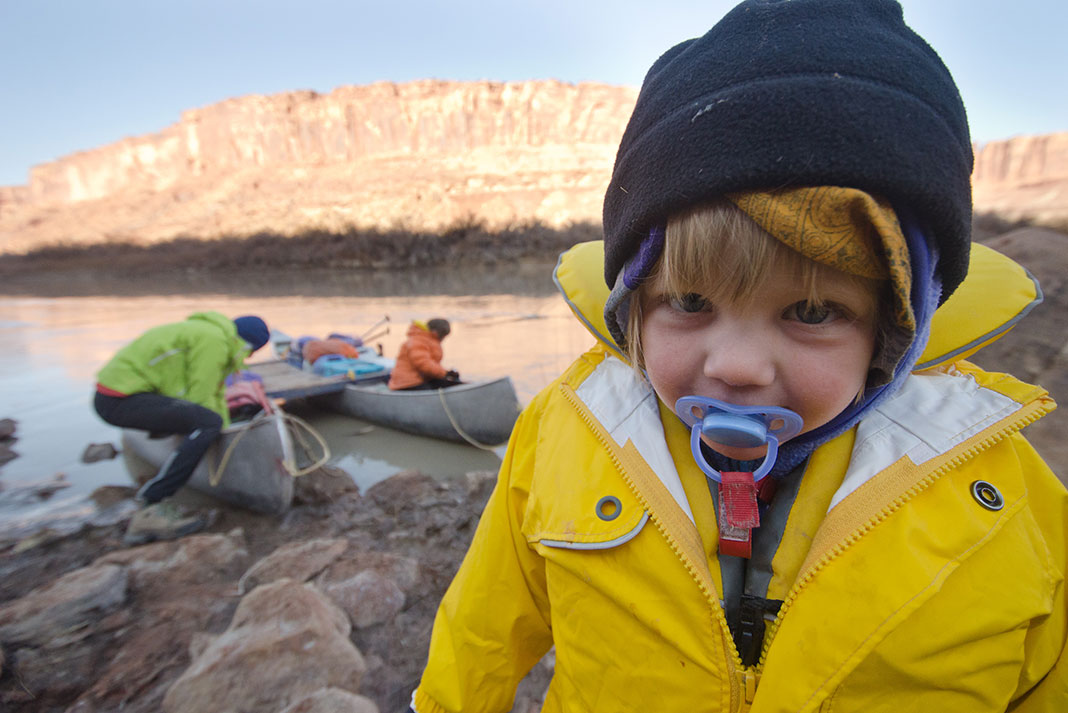Products You May Like
Parents of young children, don’t you miss the great outdoors? Great news: bringing kids along on trip doesn’t have to put a damper on your taste for adventure. Whether you love to get outside on foot, by caravan or in the cockpit of your kayak, our family camping experts share their top tips and tricks for creating amazing and memorable trips everyone will love.
29 tips for fun, worry-free family camping
8 tips to plan a family trip
-
Ignore the doubters
Your less-enlightened friends will assure you that kids mean your outdoor days are over. Step one: ignore them.
-
Never too early
Kids are never too young to get outside. “Earlier is better,” says outdoors supermom Alice Young-Clark—in some ways, it’s easier too. “We started at three months. There was no extra food or water to carry while nursing, although you do have to deal with diapers.”
-
Maintain goodwill
If you’re worried your terrific tot will become the tent terror of campground C by night, introduce yourself to your closest neighbors and offer earplugs. You’ll find most campers are just excited that your little one is enjoying the outdoors.
-
Get their feet wet
For kids new to camping, make an adventure of using sleeping bags, pads and jacket pillows at home before a trip, removing this variable from the new experience. Set up the tent in the backyard to introduce them to it before embarking on an adventure.
-
Reminders of home
Pack just a little bit of home with you. Whether it is your child’s favorite bowl and spoon or The Lorax for the thousandth reading, familiar items help anchor the idea that your family is home as long as you are together.
-
The world is your toy chest
Practice nonattachment and leave most toys behind. “Toys matter very little because kids gather many treasures along the way,” explains Young-Clark. “This way, kids learn to find and collect, and let go of things.”
-
Kids’ choice
Offer some (pre-screened) options and let your kids help plan the trip. Do they want to camp at a beach or visit a waterfall? They’ll buy in if they feel like the trip is theirs as well.
-
Double the fun
Nothing makes a camping trip more fun for your kids than when they can bring a buddy. The real bonus is for parents: whining is just not cool in front of your friends.
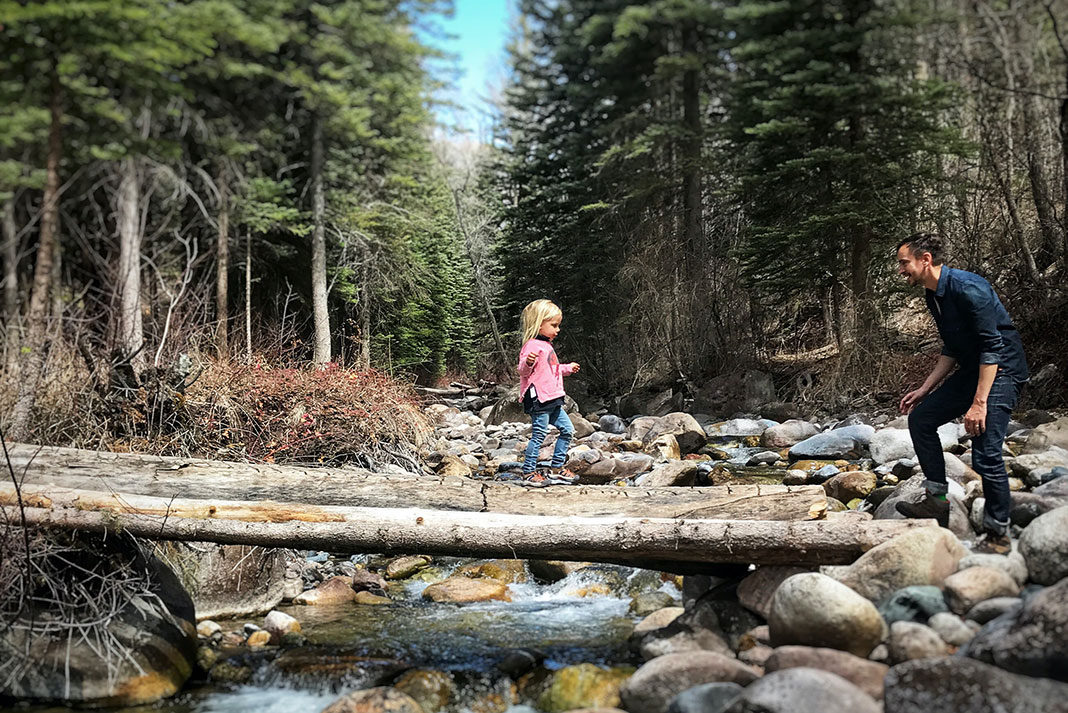
5 kid-sized camping tips
-
Ramp up to adventure
Be realistic and know your child’s limits. “The average time a kid will only spend 30 to 40 minutes in a canoe or on a hiking a trail, especially if they’re under five,” notes author Kevin Callan. “We introduced our daughter to canoe tripping slowly by going on a half-day outing, then a full day, then a weekend, and so on. If you don’t move up the ladder of progress slowly, your child will definitely come crashing down.”
-
Prepare to snack
To make longer days with kids work, take lots of breaks and eat like hobbits. “In addition to stopping for anything interesting, be sure to take regular breaks for breakfast, second breakfast, lunch, snack, supper, and bed time snack,” says Young-Clark.
-
Set attainable goals
As a rule of thumb, older kids can hike half a mile per day for each year of age. Regardless of the distance you choose, expect “Are we there yet?” to be a common refrain.
-
Fun comes first
Adults seek out big views, remote areas and wildlife. Kids just want to play. “They want to play in water, climb on rocks, crawl through narrow crevices, and throw stones,” explains Michael Lanza. “Choose destinations that you know will provide natural features that engage and excite kids. Make them want to go out again.”
-
Lose your agenda
Happy camper Callan re-learned the meaning of living in the moment from his daughter. “Kyla taught me to slow down and spend time looking at things. I remember her looking at an anthill for over half an hour,” he says. What’s important is sharing the experience. If being together is the goal, every trip will be a success, whether you’re camping by car, canoe, ski, foot or llama.
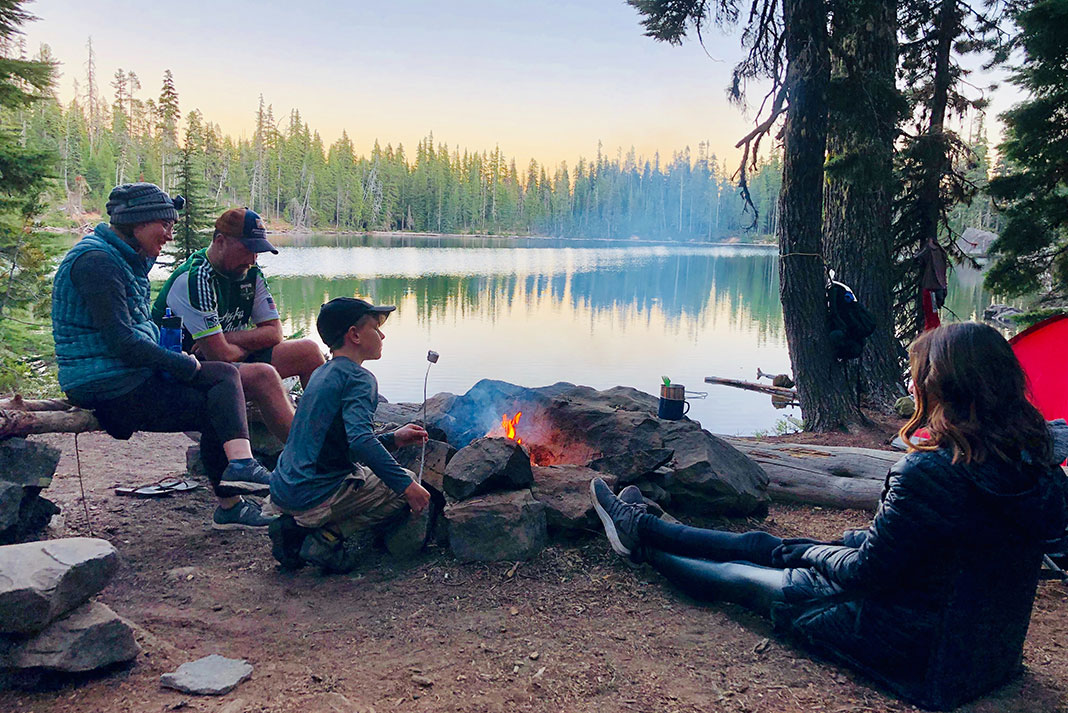
3 ways to stay entertained
-
Keep kids occupied
No matter how tired you are, your kids will still need activities to fill the day. Instead of beach naps, parents willing to play the role of camp counselor and armed with songs, stories, puzzles, crafts, cooking projects and games will be the heroes of the day.
-
Crafting a keepsake
A family trip scrapbook is a beautiful keepsake and the ultimate rainy day activity. Bring basic craft supplies and use needles, pebbles, bark and lichen from the forest floor to have everyone add their own touch to daily journal pages.
-
Budding naturalists
Bring field guides for flora and fauna in the area. Being able to point out and name local plants and animals and interesting facts about both can be a great way to keep kids aware of their surroundings.
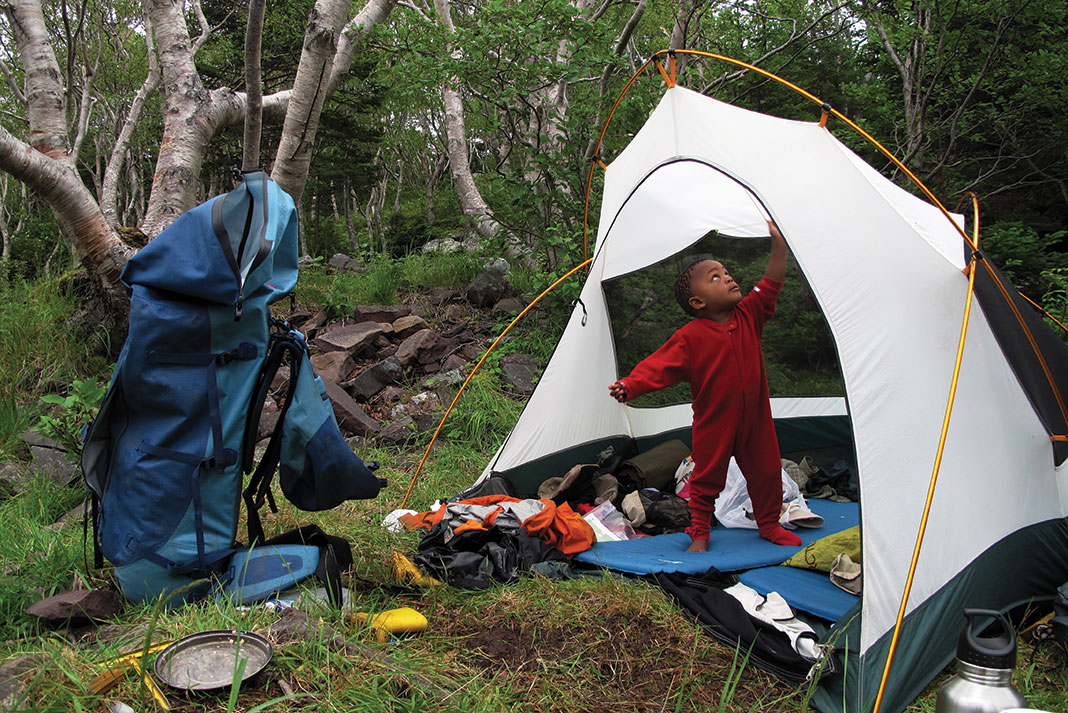
5 tips to remember on trip
-
Up off the ground
Managing the pebble and moose poop intake of a crawling toddler quickly becomes exhausting. If you have very young campers, bring a Bumbo Chair or playpen so they have somewhere off the ground to sit.
-
Pack extra padding
Your tent will become a nylon funhouse, whether you like it or not. It’s all fun and games until someone bonks their head on the root or rock that kept you awake all night. Bring an extra sleeping mat or two so kids can roll and leap at will or line the tent floor with foam floor tiles.
-
Communicate clear boundaries
Constant reminders about cliff edges and water hazards will become tedious—for you and the kids. Instead, explain the hazard and make appropriate rules together, such as clear boundaries (like, “Don’t go past that big tree” or “Wear your PFD to play near the water”). “Experienced older kids need less instruction and can be given more freedom,” explains Lanza, “but don’t assume older kids who are beginners will understand every potential hazard.”
-
Kids help around camp
Make a game of having kids help with age-appropriate camp chores. Five-year-olds can help gather kindling, an eight-year-old can help start a fire, and a 12-year-old can be responsible for a meal.
-
Laugh off the missteps
Accept that things will go wrong while on a trip. “You can count on that,” guarantees Callan. “If you can laugh at the misfortunes, the moderate ones at least, kids will learn to relax and do the same.”
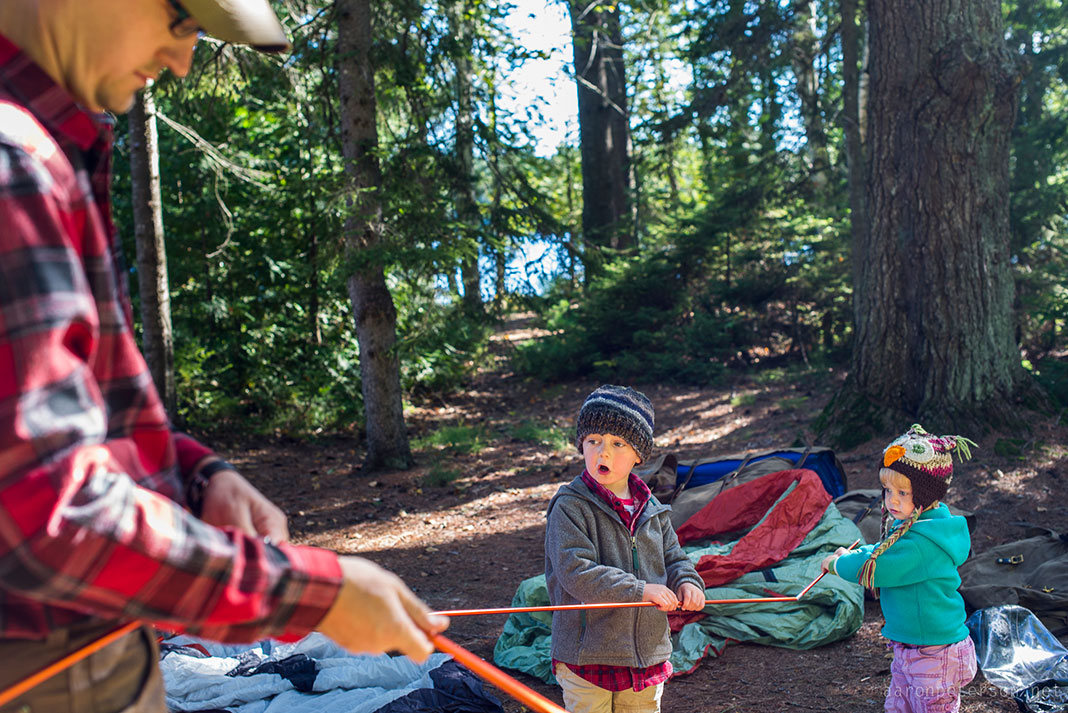
5 tips for dealing with gear
-
Ditch the stroller
Get your kids used to the idea of walking early, and they will grow into strong hikers. “I preferred a child-carrier backpack to a stroller, even in urban settings, for those occasions when my kids needed a break from walking,” explains Lanza. “It gives you exercise, is more convenient on stairs, and helps communicate to kids that our family carries packs—that we’re hikers.”
-
Timing is everything
Whether a task is perceived as a painful chore or a perk often depends on whose idea it was. Don’t force your kids to carry packs, instead wait until they ask for one, adds Lanza.
-
Prepare for the elements
Since kids can’t regulate their body temperature as well as adults, half the stress of traveling with them becomes keeping them either dry, cool or warm. Weather-appropriate layers are a no-brainer, but an ultra-light trekking umbrella is a welcome shield from the elements and will become a staple in your camp kit.
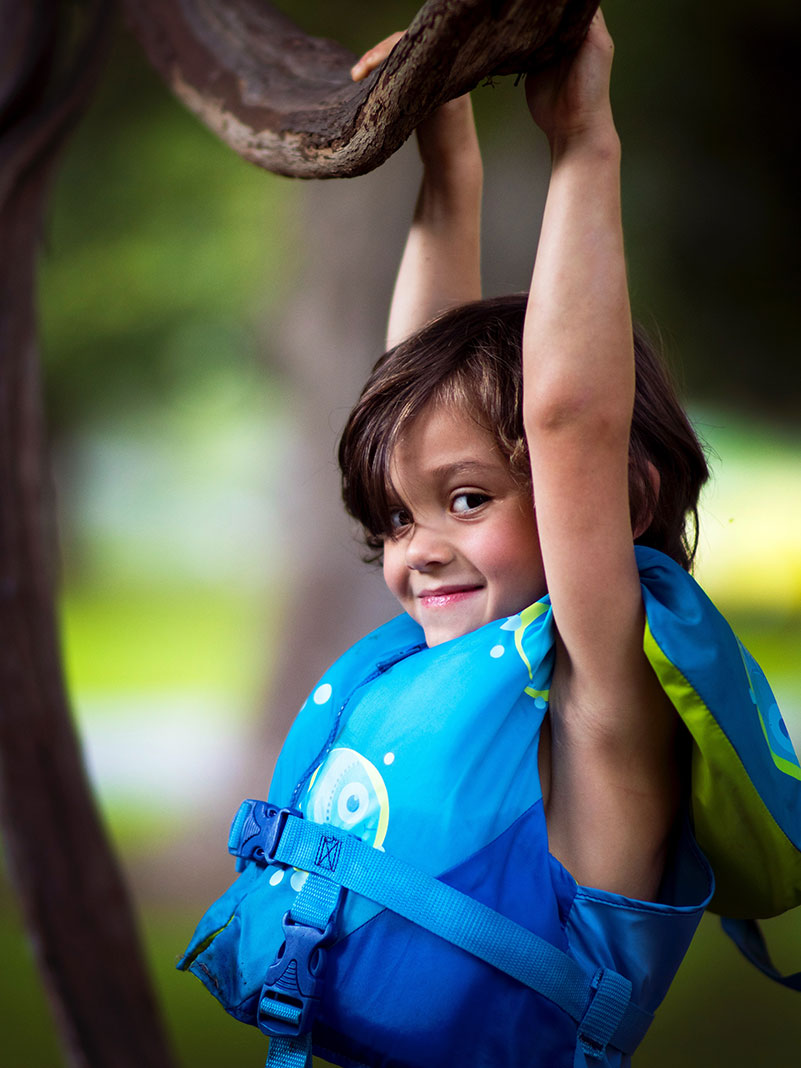
-
Age-appropriate sleeping quarters
Instead of a crib, consider using a portable shelter, such as a Kidco Peapod for babies and toddlers. It is also a great bug-proof nap nest.
3 ways to come home safely
-
Set a safe example
If you wear your PFD and helmet, your kids will wear their PFD and helmet. Parents that force their children to wear safety gear without wearing their own are asking for a battle.
-
Wear a whistle
In the backcountry, have your kids wear a whistle on a lanyard and instruct on how to use it. Explain what it means to be lost (when you can’t find Mom or Dad), and what to do: stop, blow your whistle three times, and listen for a response, then repeat.
-
Get first aid training
If you’re more than a 911 call away from help, Mom and Dad should invest in a wilderness first aid course for peace of mind.
This article was first published in the Spring 2015 issue of Canoeroots Magazine. Subscribe to Paddling Magazine’s print and digital editions, or browse the archives.
Your less-enlightened friends will assure you that kids mean your outdoor days are over. Ignore them. | Feature photo: Bruce Kirkby
